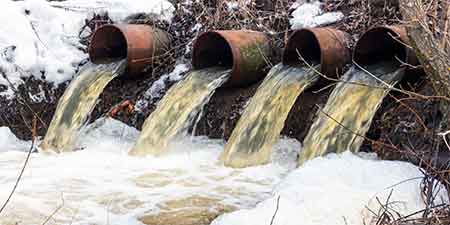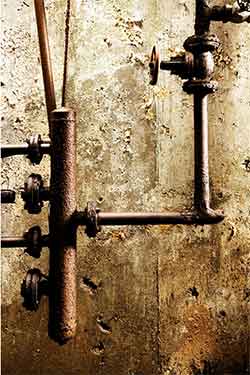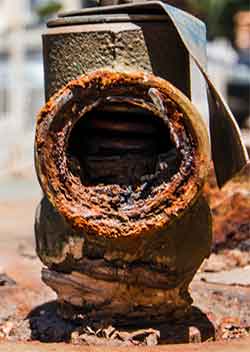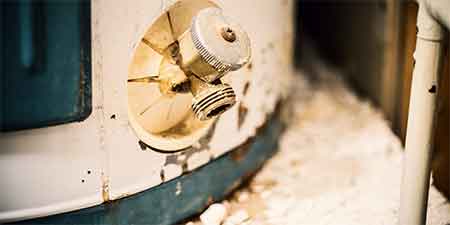February 2022 – State and federal laws in the U.S. require that the drinking water provided for public consumption by water utilities must meet a long list of quality and safety standards. But even with these stringent policies in place, the water from your tap is never going to be completely pure. This is especially true if you are among the 43 million Americans getting their water from a private well, in which case monitoring the water quality is even more important, and usually left completely up to you.

You cannot see, smell, or taste most contaminants in drinking water, and consuming water with impurities on a regular basis can sometimes lead to adverse health effects ranging from gastrointestinal issues to reproductive problems, and even cancer.
There are many sources of water contamination, including:
- naturally occurring chemicals & minerals (like arsenic & uranium)
- man-made pollutants (like PFAS & MTBE)
- local land use practices (like fertilizers & pesticides)
- manufacturing processes
- wastewater releases

What Happens Between the Source and Your Tap
Public water system operators monitor and treat drinking water for impurities that have been deemed by the EPA to be unsafe for human consumption. Many private well owners install water filtration and remediation systems in their homes to address impurities revealed by regular water quality testing. When these practices are in place, ideally, your water should be safe to drink.
Even those with routine water quality testing and treatment practices should be aware, however, that there is another potential source of water contamination not often addressed: the water distribution system in your home or building.
Deterioration of pipes, improper maintenance, and issues with various indoor plumbing elements can all contribute to poor water quality, especially in older construction. To follow are three possible sources of water contamination under your own roof that you might want to consider when evaluating the safety of your drinking water.
Pipes & Plumbing Fixtures
Before the introduction of man-made materials such as Polyvinyl Chloride (PVC), Chlorinated Polyvinyl chloride (CPVC) and cross-linked polyethylene (aka PEX, XPE or XLPE), the most common materials used for the pipes transporting water throughout a home or building included steel, iron, copper, and, before it was banned, lead.
Since metal pipe was the standard in construction all those decades ago, pipe corrosion is now a very common problem in older homes and buildings. Over time, deterioration of metal pipe may introduce metals such as iron, lead, copper, and zinc into the water you drink.
Water with high acidity or low mineral content can contribute to the corrosion of metal pipes and fixtures. Brass or chrome-plated brass faucets and plumbing with lead solder can also leach metals into your drinking water. Although it is not mandatory, “Lead Free Certification” is being adopted by many manufacturers of plumbing products today, to assure consumers that their pipes and fixtures meet the lead safety standards of the Federal Safe Drinking Water Act.
 Bottom line? Find out what your pipes and fixtures are made of and when they were installed. If the plumbing hardware in your home looks worn and/or was installed more than 20 years ago, you might consider having them inspected or replaced. And as always, the best way to know if you have unsafe levels of metals in your water is to have it tested by a certified lab.
Bottom line? Find out what your pipes and fixtures are made of and when they were installed. If the plumbing hardware in your home looks worn and/or was installed more than 20 years ago, you might consider having them inspected or replaced. And as always, the best way to know if you have unsafe levels of metals in your water is to have it tested by a certified lab.
Stagnant Water
When a water system within a home or building is not used on a regular basis, unsafe levels of bacteria, sediment, and biofilm may form within the water tanks and pipes. Biofilm is a group of microorganisms that grow and multiply together, adhering to surfaces via a slime like substance. This slimy growth can occur within a water tank or water pipe when the system sits unused for too long. Legionella and pseudomonas are particularly dangerous forms of bacteria that can grow within a biofilm environment.

Biofilm thrives in a moist, stagnant environment, and unfortunately, according to the CDC, the slime acts as a barrier to some water treatment chemicals. This means that even if your water is safe to drink at its source, if biofilm has started to grow in your plumbing, the water coming from your tap may contain harmful bacteria.
Sediment, bacteria and biofilm issues cannot be seen in a closed plumbing system, so if you have cause for concern, you may want to have your pipes and tanks inspected by a professional. You can also prevent issues by regularly “flushing” your pipes, faucets, showerheads, and water heater. Additionally, well users are advised to have their drinking water tested every three to five years, and annually for bacteria and nitrate.
Water Heaters

Water heaters should be properly maintained, flushed regularly (per the manufacturer recommendation), and in order to prevent bacteria growth, the thermostat should be set to 60°C (140°F).* Beyond the problem with bacteria and biofilm mentioned earlier, additional issues with your water heater are related to corrosion and sediment.
*some guidance materials suggest setting tank temperature to 120°F,
in order to avoid inadvertent hot water burns.
Water with brown, orange or red discoloration can be caused by rust from a corroded water heater tank (or pipes as mentioned earlier). Most contemporary water heaters come equipped with a corrosion protection anode rod, which is made of magnesium and is designed to protect the tank itself from corrosion. As the rod wears over time, you may experience discolored water, a rotten egg smell (due to sulfur), air in the lines, and/or inconsistent hot water. If the rod in your tank is several years old and you are experiencing any of these problems, you might want to have your anode rod inspected and/or replaced.

Another issue with water heaters is the sediment that tends to accumulate at the bottom of the tank, which is why it is important to periodically flush the tank. These sediments can also cause bacteria and odors. Water softeners are very effective at resolving this issue, but if you see or smell something in your drinking water, your best bet is to switch to bottled water and call a water treatment professional.
Conclusion
Whether you have a public or private water source, the quality of the water you drink cannot be taken for granted. As mentioned earlier, consuming contaminants for a prolonged period of time can cause health issues, especially among young children and the immunocompromised.
Have your drinking water tested as soon as possible if:
- you have sudden changes in the odor, taste, or appearance of your water
- you observe corrosion of pipes and fixtures
- you have recently performed plumbing or well repairs
- you or anyone consuming the water is having unexplained stomach illnesses

Remember, water quality issues are not always obvious, and some impurities in drinking water have no odor, color, or taste. Be sure to pay attention to the potential issues mentioned here, and if you have cause for concern, have your water tested by a certified laboratory to ensure your water meets the EPA’s Safe Drinking Water Standards.
Helpful Links:
- EPA Home Drinking Water Fact Sheet:
https://www.epa.gov/sites/default/files/2015-11/documents/2005_09_14_faq_fs_homewatertesting.pdf - EPA Water Quality and Human Health:
https://www.epa.gov/report-environment/drinking-water#effects - CDC Preventing Waterborne Germs at Home:
https://www.cdc.gov/healthywater/drinking/preventing-waterborne-germs-at-home.html - Find a Certified Water Testing Lab:
https://www.epa.gov/dwlabcert/contact-information-certification-programs-and-certified-laboratories-drinking-water - NSF International Water Treatment Information, via independent certification program:
https://www.nsf.org/knowledge-library/home-water-treatment-system-selection - The Water Quality Association nationwide database of Certified Water Treatment Professionals:
https://www.wqa.org/Programs-Services/Resources/Find-Providers/Find-Certified-Professionals



